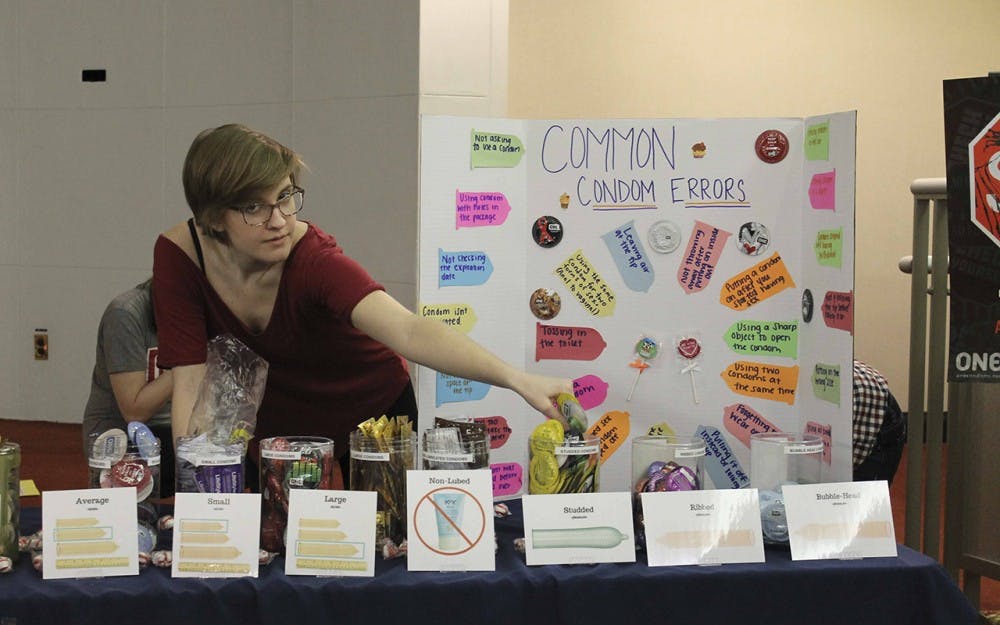Some students walking on the main level of the Indiana Memorial Union on Tuesday afternoon probably thought they saw a person dressed up as female genitalia, and they were not mistaken. They would have seen one of the attractions at the fourth annual “Cupcakes and Condoms” event.
The event was organized by the student-run Sexual Health Advocacy Group (SHAG) and featured more than 25 booths. It was a collaboration with the IU Health Center and groups like Planned Parenthood and the All-Options Pregnancy Resource Center.
Each booth featured a teaching activity for visitors to participate in, and many featured free condoms of varying materials, sizes, shapes and flavors, accompanied by explanations and tutorials. Female condoms, dental dams and miniature condoms used for foreplay involving fingers were also available.
Senior Caitlin Kee, a member of SHAG, said in addition to promoting safe sex the event was also meant to educate students about sexual health and relationships. Some booths discussed communication between partners, while Money Smarts, a program by the Office of Financial Literacy, had a booth discussing the intersection of finance and relationships.
“People don’t really think about money in a relationship until it’s too late,” said Morgan McMillan, the Assistant Director of Financial Literacy.
Phil Schuman, director of the office, said he normally hears financial concerns when it comes to buying engagement rings, though there is a tendency early in relationships to spend large amounts of money on one’s significant other.
A booth advertising a Consent Condom Race had students wear perception-skewing glasses, called Drunk Goggles, and attempt to apply condoms to a dildo on the table.
Those supervising the event asked the participants to explain their steps before proceeding, and many missed the first one, which was asking for consent. Students were reminded to check the condom they were given for an expiration date, an important step made difficult by the vision-impairing goggles.
A booth, which discussed communication in relationships, had students spin a wheel and read the scenario corresponding to the topic the wheel stopped on. These included condom usage, STI testing and HIV status.
Senior Alea Shelton, who helped run the booth, said college is a time when young adults are introduced to new experiences, which is why condom usage is especially important.
The IU Health Center booth featured a board describing the history of condom usage, dating back thousands of years. The first condoms were not worn to protect against diseases and were more like clothing, the board said, and condoms in the 1800s were as thick as a rubber tire, a fact which pharmacy technician Roberta Mank said widened eyes.
Mank ran the booth, which also promoted the Health Center’s medication delivery service. The service, which is currently available to residence halls only, also delivers emergency contraceptives like Plan B One-Step.
Mank said it is important for students to know emergency oral contraceptives were available without a prescription, and that they were available through the Health Center’s delivery service. Residence halls have a secure location to receive medication, while greek houses and off-campus housing do not, which is why the program has not yet been extended beyond campus, she said.
“If people need it, they should have it,” Mank said.
In addition to free condoms, sexual lubricant and dental dams, some tables also featured free clothing and keychains. Community Capacity for Prevention and Education, an initiative in Monroe County to prevent substance abuse and the spread of HIV in 13 to 24-year-olds, gave out T-shirts in exchange for correct answers to questions on sex, drugs, alcohol and HIV.
Olivia Humphreys, the outreach coordinator for the group, said they try to focus on situations where drugs, alcohol and sex interact, which tends to be prevalent in college.
“We really focus on risk factors in getting HIV,” Humphreys said.
A table for condom arts and crafts sat in the middle of the room, but students appeared more focused on each booth’s activity. Cupcakes were also present, though there were no condom icing designs.
Students left with gift bags containing condoms varying in flavor from none to banana, in size from small to large and in colors from clear to glow-in-the-dark.






